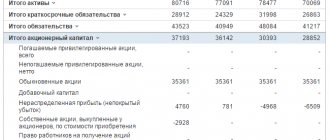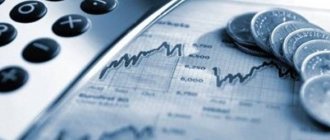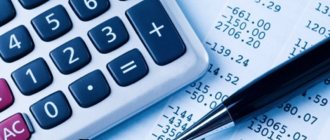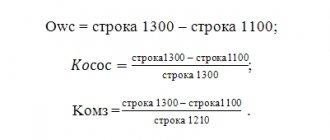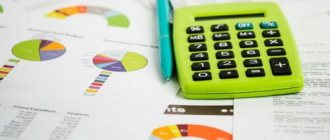What does the debt-to-equity ratio show?
They resort to calculating the debt-to-equity ratio when they want to quickly obtain approximate data on the financial situation in the organization.
It serves as one of the economic indicators and gives a general idea of the proportion of borrowed and equity funds of a legal entity. The predominance of own funds indicates a good financial position, and the dominance of borrowed funds indicates probable instability in financial terms.
It is important to know the value of this coefficient for those who invest their funds in the organization: investors, banks, lenders, suppliers providing deferments.
Find out how to assess the financial condition of a trading organization in ConsultantPlus. If you don't have access to the system, get a free trial online.
Capital ratio
It indicates the amount of own funds that accounts for one ruble of borrowed funds. It is calculated by simply dividing the volume of all borrowed funds by the volume of funds owned by the enterprise.
The standards for this indicator directly depend on the specifics of the organization’s activities. If the calculated coefficient is below 1, it means that the company operates using existing resources; if it is higher than 1, then preference is given to borrowed funds. It is worth noting that in developed countries, borrowed capital predominates, the coefficient is about 1.5 units.
Formula for determining the debt-to-equity ratio?
Calculating the coefficient is quite simple. It is defined as the ratio of the amount of all existing debts on borrowed funds (regardless of their maturity) to the amount of capital considered as own. In legend, the formula looks like this:
Kzis = BorrowCap / SobCap = (DlLoanOb + KrLoanOb) / SobCap,
where: Kzis is the ratio of borrowed and equity funds;
LoanCap - existing debts on borrowed funds;
SobKap - the amount of capital considered as own;
DlZaemOb - existing long-term debts on borrowed funds;
KrZaemOb - existing short-term debts on borrowed funds.
The data for calculation is taken from the balance sheet. Applied to its lines, the formula will look like this:
Kzis = (1410 + 1510) / 1300,
where: Kzis is the ratio of borrowed and equity funds;
1410 - line number of the balance sheet, which reflects long-term debt obligations;
1510 - line number of the balance sheet, which reflects short-term liabilities for borrowed funds;
1300 - line number of the balance sheet, which indicates the value of equity capital.
For information about what data falls into the specified lines of the balance sheet, read the article “Procedure for compiling a balance sheet (example)” .
Standard value of the indicator
It is generally accepted that the higher the value of this ratio, the higher the risk of bankruptcy of the company. However, this is very conditional and, in general, sometimes high values of this indicator are acceptable. For example, if an enterprise operates stably, in a developed economy, where there are low interest rates, a high level of business ethics, etc., then the value of this coefficient may exceed 1 (which, however, can very often be found in Western countries). Also, a high value of this indicator is acceptable if the duration of the receivables turnover exceeds the period of inventory turnover (in other words, if money quickly flows into the company and the company does not experience a shortage of working capital).
Finished works on a similar topic
- Coursework: Ratio of equity and debt capital 460 rub.
- Abstract Ratio of equity and debt capital 220 rub.
- Test work Ratio of equity and borrowed capital 210 rub.
Receive completed work or specialist advice on your educational project Find out the cost
At the same time, the standard value of the ratio of equity and debt capital varies greatly depending on the industry and the specifics of the activity of a particular enterprise.
Typically, this indicator is analyzed over time. If the value of the coefficient increases, then this will indicate a tendency towards increasing dependence of the company on financial injections from creditors and external investors. An increase in the value of this indicator also means an increase in the degree of risk for investors, since if the company does not fulfill its payment obligations, the likelihood of bankruptcy will increase significantly.
Note 2
With certain assumptions, the recommended value of this indicator should not exceed 0.7. Many researchers in the field of financial analysis believe that the most optimal value of the ratio should be in the range of 0.5-0.7. Be that as it may, exceeding the 0.7 mark is often an indicator that the level of financial stability is likely to be far from ideal.
Do you need to select material for your study work? Ask a question to the teacher and get an answer in 15 minutes! Ask a Question
The ratio of equity to debt is the debt coverage ratio
If we take the inverse ratio, then the result obtained is nothing more than the liability coverage ratio with the capital available to the company. Accordingly, the formula will look like this:
Xyz = SobCap / BorrowCap = SobCap / (DlLoanOb + KrLoanOb),
Where:
Ksiz is a coefficient showing the ratio of equity to borrowed capital.
The remaining values are identical to those specified in the previous chapter.
When the source of information is the balance sheet, the formula will look like this:
Xyz = 1300/(1410 + 1510),
Where:
Ksiz is a coefficient showing the ratio of equity to borrowed capital;
1300 - line number of the balance sheet, where the value of equity capital is indicated;
1510 - line number of the balance sheet, which reflects short-term liabilities for borrowed funds;
1410 - line number of the balance sheet, which reflects long-term debt obligations.
Impact on enterprise profitability
Financial leverage arises in those enterprises that do not have sufficient funds to conduct current activities or to increase production. Borrowed funds allow you to meet current needs and bring profit. However, the stability of the organization depends on the size of the ratio, since if the volume of borrowed funds significantly exceeds its own, bankruptcy may occur. At the same time, the risky policy is also the most profitable.
The following options for the results of applying leverage are possible:
- Positive. In this case, the income from borrowed funds exceeds the fee for their use, and the company makes a profit.
- Neutral. Income from borrowed funds is equal to the cost of maintaining them.
- Negative. Here the company suffers losses, the use of the loan does not pay off.
What is the optimal ratio of equity and debt capital?
A ratio greater than 1 (which indicates a predominance of borrowed funds over equity) is a sign of the risk of bankruptcy.
A value ranging from 0.7 to 1 indicates instability of the financial situation and the existence of signs of insolvency.
The value of the ratio of debt and equity capital, located in the corridor from 0.5 to 0.7, is considered optimal and indicates the stability of the state, the absence of dependence in financial terms and normal functioning.
A value of less than 0.5, being an indicator of a stable financial position, at the same time indicates the inefficiency of the enterprise.
However, you should not draw final conclusions based on the ratio of equity and borrowed funds alone. For a correct assessment, you need to analyze other financial and economic indicators. For example, the coefficient under consideration may have large values at a high speed of turnover of current assets.
For more information about the data that appears when analyzing current assets, read the article “Current assets of an enterprise and their indicators (analysis)” .
Interpretation of the debt-to-equity ratio
The calculated ratio of debt to equity is included in the category of indicators (markers) that show the stability (autonomy) of a business entity in financial terms.
Its meaning, in essence, is a clear demonstration of how many borrowed rubles (or kopecks) are equal to the same monetary unit of one’s own.
According to the standard adopted in Order No. 118 of the Ministry of Economy, the ratio of total borrowed and equity capital should not exceed the limit of 0.7. If the calculated coefficient is higher, we can confidently say that the organization is dependent on external lenders.
| Coefficient value | Interpretation | Interrelated indicators |
| Less than 0.5 | The enterprise is not developing, business stagnation occurs, which in the long term threatens a reduction in consumer interest and a gradual curtailment of economic activity | To build long-term forecasts, it is necessary to evaluate how the founders use earned profits. Perhaps it is reinvested in production and development occurs at the expense of its own resources. |
| Above 0.5 but below 0.7 | Attracting loans does not harm the company; the money is used to expand the business or update the material base. | It is necessary to track and analyze the cash flow of the company. If funds are used to pay off current obligations, then even if the ratio of the total amount of equity and borrowed capital varies within the standard, this is still a reason to reconsider the financial policy of the organization. |
| Above 0.7 | The enterprise loses stability and autonomy in its work. | Based on the results of financial analysis, it may turn out that current payments on borrowings and loans absorb most of the profit. It’s even worse if the newly raised funds are used to pay off interest on previously borrowed funds. |
Important! A coefficient value of more than 1 means that in the current period the company is no longer able to service its accumulated debts. In fact, the company is facing bankruptcy.
Own and borrowed funds of the organization: structure and key differences
The financial condition of an organization largely depends on what funds it has at its disposal and where they are invested.
Organizational funds are understood as monetary resources available to a business entity to carry out its activities in order to make a profit [4, p. 58].
According to the degree of ownership, the capital used is divided into equity and borrowed capital.
Own funds are funds at the disposal of the enterprise, generated from internal sources.
Own funds include authorized capital, accumulated capital and other income. The structure of own funds is shown schematically in Figure 1.1.1
Rice. 1.1.1 Structure of the organization’s own funds [13, p. 235]
Now we will consider in more detail the sources of formation of own funds [7].
The authorized capital determines the minimum amount of property that guarantees the interests of its creditors. The composition of the authorized capital depends on the legal form of the enterprise. The authorized capital adds up
— from contributions of participants for business partnerships and limited liability companies;
— nominal value of shares for a joint-stock company;
— property shares;
— authorized capital allocated by a state body or local government.
Additional capital characterizes the amount of additional valuation of non-current assets, which is carried out in the prescribed manner, as well as values received free of charge and other similar amounts.
Reserve capital is created in accordance with the law to cover unproductive losses and damages, as well as payments of income (dividends) to participants in the absence or insufficiency of profit for the reporting year for these purposes.
Reserve funds are created to cover upcoming expenses, payments, doubtful debts (to the enterprise), for the upcoming payment of vacations to employees, for the payment of remunerations based on the results of work for the year, to cover the upcoming costs of repairing fixed assets, etc.
Reserves are formed in accordance with legislation, constituent documents and accounting policies adopted by the enterprise. The main source of formation of reserves (funds) is net profit. In a market economy, reserve capital acts as an insurance fund created for the purpose of compensating for losses and ensuring the protection of the interests of third parties in the event of insufficient profit from the enterprise [11, p. 45].
Accumulation funds are funds used to finance capital investments.
Targeted financing and revenues are funds allocated to an enterprise by the state (municipality) or sponsor to carry out certain targeted activities.
Lease obligations are payments to an enterprise for fixed assets leased from it.
Retained earnings are the profits remaining at the disposal of the enterprise after the payment of income (dividends) to participants and the repayment of liabilities.
Depreciation deductions are part of the proceeds, usually directed to accumulation funds, repair funds, etc.
The organization's own funds are accounted for in section III of the balance sheet.
Two main components can be distinguished as part of equity capital [10, p. 359]: invested capital, that is, capital invested by the owners in the enterprise, and accumulated capital, that is, created in the enterprise in excess of what was initially advanced by the owners.
Invested capital includes the par value of common and preferred shares, as well as additional paid-in capital. The first component of invested capital is represented in the balance sheet of Russian enterprises by authorized capital, the second by additional capital.
Accumulated capital is reflected in the form of items arising as a result of the distribution of net profit: reserve capital, accumulation fund, retained earnings, and other similar items.
A decrease in the share of equity capital entails a deterioration in the creditworthiness of enterprises. In addition, given that indicators of equity and debt capital are used to calculate the profitability of investments in the enterprise of various investors, it can be assumed that overestimating the volume of liabilities in total liabilities will negatively affect the objectivity of indicators characterizing the “price” of capital.
As part of equity capital, it is necessary to highlight the share of its individual components, as well as reflect the dynamics of its composition and structure over recent periods. The need to separately consider items of equity capital is due to the fact that each of them is a characteristic of legal and other restrictions on the ability of an enterprise to dispose of its assets [3, p. 127].
Borrowed funds are the capital of an organization formed from external sources: loans from banks and financial companies, loans, accounts payable, factoring, leasing, bills, bonds.
The sources of borrowed funds of the enterprise are [8]:
- bank loans - characterize the amount of debt on funds borrowed from banks at interest.
— loans are debt on loans received from other enterprises. These include advances from buyers and customers.
— factoring and leasing transactions are a type of commercial loan. Provide the organization with fixed and working capital.
- accounts payable. Creditors are legal entities and individuals to whom enterprises have a certain debt [12, p. 120]. The amount of this debt is called accounts payable. Accounts payable may arise as a result of the existing system of settlements between enterprises, when the debt of one enterprise to another is returned after a certain period after the debt arose, in cases where enterprises first reflect the occurrence of debt in their accounts, and then, after a certain time, repay this debt due to absence the enterprise has funds for settlement.
Borrowed capital, unlike equity, is classified into long-term and short-term. Short-term loans include loans for up to a year, long-term loans for a year or more.
Funds raised on a long-term basis are usually used to purchase long-term assets, while current liabilities are usually a source of working capital.
To assess the structure of obligations, it is very important to divide them into unsecured and secured [1, p. 95]. The importance of such a grouping is due to the fact that secured obligations in the event of liquidation of the enterprise and the announcement of bankruptcy proceedings are repaid from the bankruptcy estate.
The more secured debts, as opposed to unsecured, the better for the secured creditors, but the worse for the remaining creditors, who must be satisfied with the remaining estate in the event of a bankruptcy.
Over the long term, a company's value depends more on its marketing, investment, and production decisions than on its financing decisions. And if a company has extensive investment prospects with positive net present values, easy access to sources of financial resources is of utmost importance.
In addition to the above, it should be taken into account that the costs associated with obtaining a loan are significantly lower than the costs associated with the issue and public offering of shares. Many companies cannot afford to issue shares, and borrowing becomes the only alternative for them to count on business growth.
In addition, debt may be issued in the international capital market to hedge against changes in exchange rates or as a way to protect against political risk. Macroeconomic trends cannot be ignored either. As a rule, during a period of declining business activity, firms with a high debt load lose their market share to competitors with a more conservative capital structure, including those who preferred moderate growth using only their own profits or using shareholder funds [6].
In modern conditions, capital structure is a factor that has a direct impact on the financial condition of an enterprise - its solvency and liquidity, the amount of income, and profitability of operations. The assessment of the structure of the enterprise's sources of funds is carried out by both internal and external users of accounting information. External users - banks, investors, creditors - evaluate the change in the share of the enterprise's own funds in the total amount of sources of funds from the point of view of financial risk when concluding transactions. It is obvious that the risk increases with a decrease in the share of equity capital. Internal analysis of the capital structure is associated with the assessment of alternative options for financing the activities of the enterprise. In this case, the main selection criteria are the conditions for attracting borrowed funds, their “price,” the degree of risk, and possible areas of use.
In foreign practice of financial analysis, the ratio of debt and equity capital is one of the key ones and is considered as a way of assessing risk for the lender. Creditors have the right to require the signing of an agreement, according to which this ratio cannot exceed a certain limit. Under these conditions, some enterprises seek to artificially reduce the amount of liabilities using their off-balance sheet reflection.
Examples of problem solving
Example 1
Based on the balance sheet data, evaluate the stability of the enterprise over the past 3 years.
| 1 year | 2 year | 3 year | |
| Long-term liabilities | 145000 | 134000 | 120000 |
| Short-term loans | 120000 | 280000 | 160000 |
| Equity value | 358000 | 320000 | 580000 |
Solution. Debt to equity ratio for the 1st year:
Z C = ( 145000 + 120000 ) 358000 = 0.74 \frac{\text{Z}}{C}=\frac{(145000+120000)}{358000}=0.74 CZ=358000(145000+120000 )=0.74.
Debt to equity ratio for the 2nd year:
3 C = ( 134000 + 280000 ) 320000 = 1.29 )=1.29.
Debt to equity ratio for the 3rd year:
Z C = ( ( 120000 + 160000 ) 580000 = 0.48 \frac{\text{Z}}{C}=\frac{((120000+160000)}{580000}=0.48 CZ=580000(( 120000+160000)=0.48.
Conclusion: the first year - the stability indicator is slightly above the norm, in the second year there is an unfavorable increase in it due to short-term loans, but the situation levels out in the third year due to an increase in the share of own funds and a decrease in the amount of borrowed funds.
Example 2
The amount of long-term loans of the holding is 3.5 million rubles. Share of own funds 14 million rubles. What should be the maximum cost of short-term loans to be in the sustainability zone (0.5-0.7)?
Solution.
K = ( D+K) CK=\frac{(\text{D+K)}}{C} K=C(D+K)
( D+K) C = 0, 7 \frac{(\text{D+K)}}{C}=0.7 C(D+K)=0.7
3, 5 + K = 0, 7 ∗ 14 3.5+K= 0.7 * 14 3.5+K=0.7∗14
K = 9, 8 − 3, 5 = 6, 3 K=9.8-3.5=6.3 K=9.8−3.5=6.3
Answer: maximum loans up to 1 year can be 6.3 million rubles.
The debt-to-equity ratio allows you to assess financial stability and the degree of fulfillment of obligations to third parties. Timely adoption of measures to increase the ratio will reduce the risk of activity and consolidate your position.
